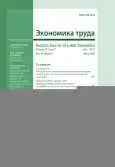Распределение продолжительности использования рабочего времени и среднемесячной заработной платы по профессиональным группам
- Авторы: Кипервар Е.А.1, Побиянская А.В.1
-
Учреждения:
- Омский Государственный Технический Университет
- Выпуск: Том 10, № 7 (2023)
- Страницы: 1031-1042
- Раздел: Статьи
- URL: https://journals.eco-vector.com/2410-1613/article/view/607830
- DOI: https://doi.org/10.18334/et.10.7.118653
- ID: 607830
Цитировать
Полный текст
Аннотация
В статье представлены результаты исследования взаимосвязи фактической продолжительности рабочего времени и среднемесячной заработной платы в зависимости от профессиональных групп за последние 30 дней. Материалы и методы. Исследование проводилось на основании анализа базы Российского мониторинга экономического положения и здоровья населения НИУ ВШЭ. Данная база репрезентативна для Российской Федерации. Мониторинг охватывает социально-экономические показатели, такие как доходы, расходы населения, рабочее время, структура занятости и др. Также он включает демографические вопросы: возраст, пол, семейное положение, образование и др. В среднем опрашивается примерно 10,0–12,0 тысяч человек в ходе исследования. Расчеты выполнены в среде IBM SPSS Statistics. Результаты исследований и их обсуждение. Уровень заработной платы не всегда соразмерен с затратами рабочего времени работника. Однако прослеживается примерно одинаковая динамика, как в использовании рабочего времени, так и заработной плате по профессиональным группам работников. Исследование показывает, что высокий уровень заработной платы достижим при нормальной занятости и серхзанятости, хотя наблюдаются исключения и при недозанятости.
Ключевые слова
Об авторах
Елена Анатольевна Кипервар
Омский Государственный Технический Университет
Email: kipervar@list.ru
кандидат экономических наук, доцент, заведующий кафедрой «Экономика и организация труда»
Анастасия Валерьевна Побиянская
Омский Государственный Технический Университет
Email: batueva-nastya@mail.ru
старший преподаватель
Список литературы
- 1. Борисова С.Н. Изучение профессиональных групп в отечественной социологии: основные теоретико-методологические подходы // Вестник Нижегородского университета им. Н.И. Лобачевского. Серия: Социальные науки. – 2016. – № 2(42). – c. 144-148.
- 2. Вовк О.Ю. Система оплаты труда: понятие, формы и основные принципы организации и регулирования оплаты труда // Вестник науки. – 2020. – № 10(31). – c. 26-31.
- 3. Дружилов С.А. Влияние профессиональной группы и профессионального сообщества на становление и сохранение индивидуального профессионализма // Современные научные исследования и инновации. – 2015. – № 3-5(47). – c. 82-87.
- 4. Мансуров В.А., Юрченко О.В. Социология профессиональных групп: история становления и перспективы // Вестник Института социологии. – 2013. – № 7. – c. 091-106.
- 5. Модорский А.В. Стимулирующая функция заработной платы в системе функций заработной платы // Вестник Пермского университета. Серия: Экономика. – 2014. – № 1(20). – c. 97-102.
- 6. Подмарков В.Г. Человек в мире профессий // Вопросы философии. – 1972. – № 8. – c. 53-62.
- 7. Российский мониторинг экономического положения и здоровья населения НИУ-ВШЭ (RLMS-HSE), проводимый Национальным исследовательским университетом «Высшая школа экономики» и ООО «Демоскоп» при участии Центра народонаселения Университета Северной Каролины в Чапел Хилле и Института социологии Федерального научно-исследовательского социологического центра РАН. Rlms-hse. [Электронный ресурс]. URL: https://rlms-hse.cpc.unc.edu (дата обращения: 12.02.2023).
- 8. Тихомирова Т.П. Функции заработной платы: теоретический аспект и анализ реализации // Экономика региона. – 2010. – № 4(24). – c. 46-51.
- 9. Белоконная Л., Гимпельсон В., Горбачева Т. и др. Формирование заработной платы: взгляд через «призму» профессий. - М.: ГУ ВШЭ, 2007. – 44 c.
Дополнительные файлы








